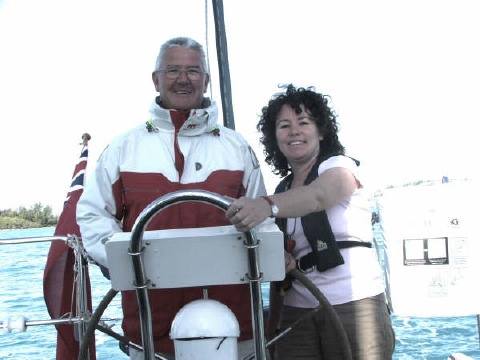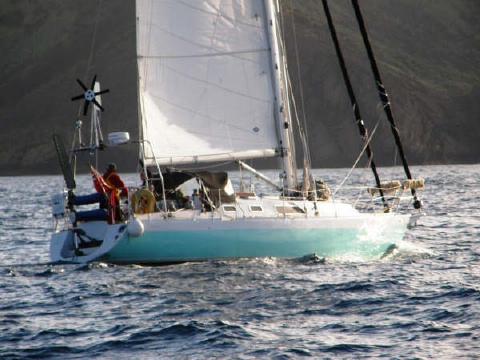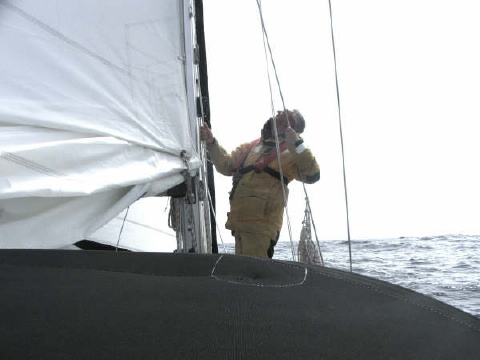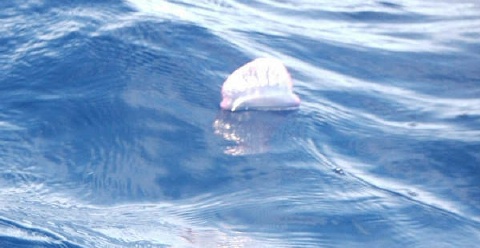
Leaving Bermuda in a happy mood
Living the dream
Bermuda and the voyage to the Azores
May-June 2008
While Siobhán was in Ireland for her preliminary interview and happily for her second and also successful interview, I was gainfully employed overhauling and mending parts of the boat, which had not come up to scratch during the voyage from the USA to Bermuda. Fortunately, they were few and described in my previous update. I occupied myself for a couple of days by hiring a scooter and touring the island. This was an excellent way to view this beautiful mid-Atlantic oasis, because one can stop where one wants, detour down small lanes, drop down to a magical beach and park easily in the busy metropolis of Hamilton, the capital. I thoroughly enjoyed the freedom it gave me from the boat and the repairs.
When we had first arrived at Captain Smoke’s Marina we were the only boat and tied alongside, with bow and stern tied to anchor warps to blocks offshore, to keep one from being driven into the quay. Captain Smoke’s is a bare-faced quay with one shower and toilet, electricity and water. When yachts are tied stern to the dock there is room for between 6 to 8 boats lying side by side, which gradually came to pass. However, shortly afterwards there were warnings of severe gales from the south-west and all but two boats, ours and ‘Impromptu’, a Hallberg Rassey 46, scampered off to shelter. We therefore had the quay virtually to ourselves until the day before we left. It was a useful base to get the various bits and pieces done and to provision up.
Eventually, Siobhán returned to Bermuda and informed me in the taxi returning from the airport that she had been successful in her interviews. I was almost in tears with the joy of seeing her again and with the absolutely marvellous news that she had secured this fantastic post and would be working within 12 miles of where we will be living in Ireland.
Over the moon
Moreover, the scope of responsibilities will thoroughly exercise her mind and utilise her ample capabilities. We are individually and mutually delighted with this opportunity, which will enable us to settle in Ireland efficiently, effectively and economically. Needless to say, Siobhán’s family are also over the moon about our move to Ireland.
Our guests had agreed reluctantly to go off the boat for two nights, so Siobhán and I could have some private time together. The boat is an excellent ocean going boat for four persons but not suitable in a marina for four people with all their baggage. Because part of the saloon is taken up with two sea berths and one of those was full to busting with excess baggage, the saloon was not private, comfortable or tidy. This far from ideal situation became more strained as the voyage progressed, due to several aspects of our guests’ quotidian lifestyle.
The promised gales eventually arrived. While Siobhán, Kent and Mary Lou went into Hamilton to provision, I stayed on Light Blue, just in case lines parted and I needed to move her, and experienced winds up to 59.8 knots. We had tied up to three of the offshore anchor lines and were protected on the starboard side by the Hallberg Rassey, so I felt happy about our position. No lines parted and there was no damage.
While in Bermuda, we were able to meet and have two thoroughly relaxing and entertaining evenings with Siobhán’s cousin Geraldine, her partner Will and their friends. It gave us a pleasant insight into the life of ex-pats working and living in the offshore banking and insurance world. Will also took us for a very fast ride (at about 30 knots) around the island in his beloved motor boat, giving us another view of this beautiful island paradise. Exhilarating and brain-clearing fun!
Fast sailing
During the last week of our stay in Bermuda, we watched the weather synoptic pictures, supported by our own Inmarsat weather forecasts until I decided we could leave and travel towards the Azores in a north-easterly direction blown by strong south-westerly winds on the south-east side of a depression followed by southerly winds on the western side of the Azores high. Well that was the theory, but we had found that in practice our experiences could be much different.

This is the life!
In reality and on this particular leg of the voyage it worked very well; so well that it only took us 13 days to cover 1700 miles. I will go into detail about this very important leg of our two-year round the Atlantic adventure.
We cast off from Captain Smoke’s at 0830 hours on the 15 May 2008 and headed out through Town Cut and into the much windier and rougher Atlantic, experiencing 30 knot northerlies virtually straight away. Still, we were pleased for the strong winds, reefed down and settled into our watch-keeping system straight away.
The wake and winds were, however, too much for our guests, who took to their beds for several hours, due to excitement and seasickness. Siobhán and I felt queasy too due to the adverse motion of the north-westerly cross-swell, but were happy to be in the open ocean once more. By 1100 hours we had three reefs in the main and a quarter working jib.
At 0900 the following day I wrote, ‘101 miles from St George’s, Bermuda. Not a bad day considering the gale force winds and queasiness in the team. We hope for better the second day.’
The winds did not abate for several days, but the crew were all back on their feet and coping well with the weather and the watch system. On 18 May, I wrote, ‘Today has been idyllic with blue skies since dawn, warm zephyrs blowing across the cockpit, but variable, so unable to sail. We had a particularly hard day yesterday with Kent, Siobhán and me taking two hours about at steering whilst enduring yet another constant gale for several times during the day and night. Mary Lou is not experienced enough at sailing, let alone steering in such stiff winds, but she catered for us during the day and night, which is most important. The wind indicator at the masthead is swinging from one side to another. I await a settled breeze. We still have three reefs in the main, but it helps with the slatting. Fixed the autohelm loose wire.’

Still standing
On the 19th, Siobhán wrote, ‘Wind has not changed all day — variable 2. NW swell as wide as a football pitch and as high as a bungalow.’ The wind then settled and blew from the south-west, ‘all reefs were shaken out and we sailed with full main and working jib, engine off, peaceful morning, heading for destination at 5-6 knots.’
However, by 1700 we had three reefs and half a working jib, winds up to force 9, severe thunderstorms and torrential rain. Visibility was down to 100 yards, so I switched on the radar and detected nothing. Later that night, with clear visibility, a large fishing boat passed down our port side and although Siobhán called, she received no reply, but heard two boats talking on VHF in an oriental language.
On 20 May at 12 noon, I wrote, ‘Three reefs and full working jib. 148.5 NM (nautical miles) noon to noon.’ This had been a very good run. We were experiencing excellent south-westerly winds from force 5 to 6 and then late in the afternoon of the 22nd the wind backed to southerly and blew from there at force 4 to 6 for four days, hurrying us on our way.
Despite this wonderful easy sailing, during this period it was obvious to Siobhán and me that our guests were not enjoying the voyage as much as us and for reasons which it would not be correct to describe here. We had agreed with them before the trip that at any stage of the trip from Fort Pierce in Florida to Kinsale in Ireland, either couple could indicate that they wanted to part company. We therefore decided that when we reached Flores in the Azores, we would tell them that for them the voyage was ended. It would not have been safe to indicate this decision in the middle of an 1800-mile transit, so we maintained the status quo until we arrived in Flores.
On 23 May, I switched on the engine to make water as we had 263 litres left in the tank, but I wanted to top up the tank to its full capacity of 396 litres (about 80 gallons) using the clean waters of the Atlantic and reverse osmosis. Unfortunately, we spotted a substantial leak in the area of the membrane compartment and despite my attempt to re-plumb the piping, the leak still continued. From then on we practised water rationing, allowing about 50 litres a day, which for onboard use is quite sufficient. We had 660 miles to go to Flores, or about five days sailing at the speed we were achieving.
On that day we spotted two turtles, one empty water bottle, a football fishing float, two paint cans and a pod of dolphins. Being on watch in mid-Atlantic far away from the usual commercial shipping routes one has to remain on constant watch for the odd vessel that might cross one’s path. Keeping the attention alive is made easier by spotting items like the above. These were interspersed with many of the Portuguese man-of-war pods, which floated past us like the plastic wrappings of tools or toys.
Danger afloat

Portuguese Man-of-war
The Portuguese man-of-war (Physalis physalis) is not a jellyfish, but is a colony of hydroids. The floating bladder may be only 15 cm (6 inches) long, but the tentacles, which carry stinging cells, can stream out for 12 metres (40 feet). The stings are not fatal, but can incapacitate, so should be treated as extremely dangerous.
On 26 May I wrote in the log, ‘Over the last three days noon to noon, we have covered 423 NM, an average of 141 NM per 24 hours, which is absolutely marvellous. The sky is light blue, the sea sparkling, the winds steady on the starboard beam at force 4/5 and we are creaming along at 6.8 to 7.8 knots. A perfect day. Only two days to go.’
During this time different watches spotted one or more yachts off to our port side, seemingly headed in the same direction as us. Siobhán had a three-way conversation with one of the yachts and a 300-foot long commercial ship, exchanging positions and ensuring that we were not on a collision course.
And so life continued onboard Light Blue, with the three-hour watches ticking away the days and the log clicking away the miles until on 28 May at 0630 hours, I spotted an island dead ahead off the port bow, looking as though it was in sunshine. I checked the chart and measured that we had only 29 miles to travel to Flores our destination for the last 13 days.
On the approaches to Flores, a sailing vessel ‘Aries’ had lost engine power and was wallowing in the swell. We dropped our mainsail and furled our genoa and offered assistance, but they had already arranged with their sailing companions on the yacht ‘Nadir’ to tow them into harbour.
At 1545 hours we anchored quietly and safely in Lajes harbour among about a dozen cruisers of about the same size as Light Blue.
I had to report as soon as possible to customs, police and immigration, so I blew up the dinghy and took out the outboard motor, which started grudgingly. We noticed, however, that no cooling water was passing through the motor, so turned it off. It had been months since we had used it and we had wiped it down before clamping it in its normal location in the forecabin. Forgotten for months, what could we expect?
By then it was too late to visit the authorities, so I left it till the following morning and rowed ashore in rain and through 2-foot waves to be met by a friendly official, who allowed me (wet and uncomfortable) to sit in his warm and comfortable car to complete the form, which sufficed for all the separate authorities. I then walked up the steep hill to get some bread for breakfast and rowed back to the boat.
While breakfast was being prepared by Siobhán, I let our guests know our decision about parting company, saying that having two other people on board had upset our equilibrium. I indicated that they would be sailing with us to Horta (120 miles away), because it was easier to get ferries and flights from there.
Three days after arriving in Flores, we sailed out at 0830 hours on 31 May and at 0645 the next day, after motoring for most of the way, the island of Faial was just beginning to appear. On the way into Horta, we passed Juan, a Spanish single-hander on ‘Vagabonde’ and we each took photographs, which we later exchanged, by way of memory sticks, DVDs and photographs, which I had printed on our portable printer.
At 0930 on 1 June we tied up to the crowded reception dock of Horta marina, surrounded by dozens of cosmopolitan sailors and myriad types of yachts. Truly a yachtsman’s haven.
Since then, Kent and Maria Luisa have left us. Siobhán has thoroughly cleaned the boat from top to bottom, we have had the engine mounts replaced, the engine exhaust pipe cleaned, we are awaiting the fitting of a new Raymarine autohelm drive. We hired a car and yesterday we visited the National Park at Punto dos Capelhinos, where in 1957 a volcano grew out of the sea around the lighthouse at that point. We had a sumptuous lunch at Ponta do Varadouro, overlooking the calm Atlantic, before visiting the artisans’ lacemaking and other crafts school. We observed several stretches of the round island off-road car rally during our drive around the island and finished off with a visit to the local agricultural fair, where we saw horse-riding displays, prize bulls and cows and various town displays in small exhibition halls in the agricultural showground. What a full day.
Yesterday, we visited the ‘Zona de Protecçao Especial da Caldeira e Capelinhos’. This is the volcanic crater in the very centre of the island. It was absolutely fantastic. We walked right around the rim of the crater, some four miles, which took us two and a half hours and enjoyed every minute of it. The photographs reflect our happiness.
And are we enjoying ourselves? Very much! Are we relaxed? Yes! Has our equilibrium been restored? absolutely! Paradise regained.
We were going to leave on Wednesday 11 June, when we were to slip the lines once more and head north-east towards Kinsale in Ireland 1050 miles away. However, the harbourmaster has just informed us that they are expecting 60+ knots of wind later and they have taken our 45 lb CQR anchor and placed it at the end of 40 metres of leaded line at 90 degrees to our stern to ensure we will not be blown into the other boats along our pontoon, as we are the second boat in and our stern is sticking out. The winds are due to last until Thursday. We have stripped the deck and tied the genoas and feel that we are ready for anything that might be thrown at us.
Love to all
Siobhán and Lawry
Monday 9 June 2008, Horta, Faial, Azores.
Go to the ... Archives
... or see the photos from this report
